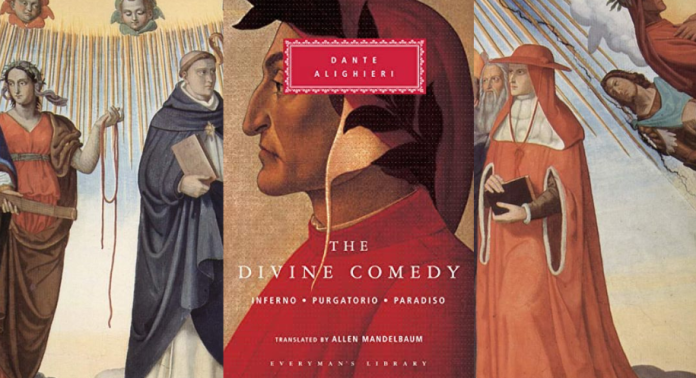“The glory of him who moves everything
through the universe penetrates, and shines
more and less elsewhere in one part.”
This review of Dante’s Paradiso is the final part of a three-article series discussing the Divine Comedy.
Like the preceding volumes in the Divine Comedy, Dante provides a well-defined geography of his paradise. Based upon the geocentric model of astronomy, Paradiso is comprised of nine concentric spheres surrounding the Earth ‒ known in text as the Spheres of Heaven, with each sphere correlating with the angelic hierarchy. At the very edge of the Spheres of Heaven is a region abode by God beyond physical existence known as the Empyrean.
Like the preceding volumes, proximity to God denotes goodness; however, while the structures of Inferno and Purgatorio are concentric spheres delimited by classifications of sin, the structure of Paradiso is based on the four cardinal virtues and the three theological virtues.
Perhaps the most notable variance between Paradiso and the earlier volumes is the inclusion of Beatrice as Dante’s guide in place of Virgil. Beatrice is a monumentally significant character to Dante, in his real life and the fictionalised version in the Divine Comedy.
Beatrice Portinari was a thirteenth-century Italian woman, whom Dante became besotted with at first sight. Although they are reported to have only met twice, Beatrice became a principal inspiration for two of Dante’s most notable works ‒ Divine Comedy and Vita Nuova. It is pertinent to note that scholars debate if Beatrice Portinari is the Beatrice from the works of Dante, however, contemporarily many accept her identification.
Paradiso picks up where Purgatorio left off, with Dante and Beatrice in the Earthly Paradise atop Mount Purgatory. As with Inferno and Purgatorio, Paradiso revolves around Dante’s journey through the realms of the afterlife, in this, the final volume, Dante documents his ascension through the Spheres of Heaven towards God.
Like the subject of earlier instalment in this series, the difficulty and ultimately the reader’s experience of the text can be significantly affected by the translation ‒ particularly intelligible and enjoyable translations of Paradiso (to the contemporary palate) include Clive James’s (2013) and A. M. Esolen’s (2004).
“High imagination here lacked power;
but my desire and winds were already turning,
like a wheel that is equally moved,
the love that moves the sun and the other stars.”
This review of Paradiso by Dante Alighieri is the tenth instalment of a fortnightly series called 50 Books. The series shines a spotlight on classical literature from throughout history and all over the world. If you have suggestions for future instalments comment and let me know.
Next time: The Sesotho classic, Chaka by Thomas Mofolo
Words by Luke Horwitz
Want more Books content from The Indiependent? Click here!
Support The Indiependent
We’re trying to raise £200 a month to help cover our operational costs. This includes our ‘Writer of the Month’ awards, where we recognise the amazing work produced by our contributor team. If you’ve enjoyed reading our site, we’d really appreciate it if you could donate to The Indiependent. Whether you can give £1 or £10, you’d be making a huge difference to our small team.
